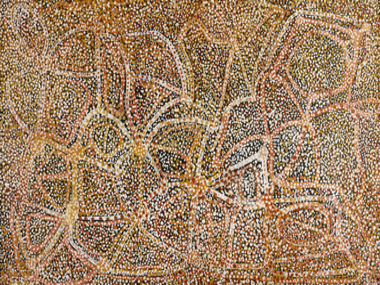EMILY AT MOMA

Ankerr (Emu)1990 by Emily Kam Kngwarray [Australian], c. 1910-1996. Synthetic polymer paint on canvas 120 x 179.1 cm Kluge-Ruhe Aboriginal Art Collection, University of Virginia © 2011 Artists Rights Society (ARS), New York /VISCOPY, Australia
Posted by Jeremy Eccles | 07.01.11
Dates:
21.11.10
: 07.02.11
Location: Museum of Modern Art, New York
It is, of course, a joy to discover that a big international contemporary art show at an institution as prestigious as the Museum of Modern Art in New York has quite casually included Our Emily alongside Miro, Mondrian, Calder, Schwitters, Kandinski and Richard Long. There are two Kngwarreye works in the two and a half month-long show, On Line: Drawing Through the Twentieth Century, which offers the following rationale for its curation:
The exhibition aims to challenge the conventional definition of drawing as a work on paper by exploring the radical transformation of the medium throughout the last century, a period when numerous artists critically examined the traditional concepts of drawing and expanded its definition in relation to gesture and form. The exhibition brings together approximately 300 works, many drawn from MoMA’s collection, by over 100 artists from over 20 nations. Crossing disciplinary boundaries, these works relate drawing to selections of painting, sculpture, photography, film and dance (represented by films and documentation, as well as live performances).
The exhibition was organised by Catherine de Zegher and Connie Butler, The Robert Lehman Foundation Chief Curator of Drawings at MOMA. And the former name should be becoming familiar in Australia – as de Zegher is co-Directing the 2012 Biennale of Sydney. So perhaps Emily's selection didn't come quite out of the curatorial blue.
Here are her colourful thoughts on Kngwarreye's 'drawing' – though I do have to wonder whether the artist herself ever saw her creations as drawing:
“Virtually no narratives were recorded to enable the viewer to decode Emily Kame Kngwarreye’s revolutionary canvases, which are left to speak only in terms of their visual components and inner properties of drawing. Kngwarreye’s work, in its audacious compositions of nothing but dots (Alagura, 1993), bold horizontal stripes (Untitled (Awelye), 1994 – 9, or tangled lines (Untitled, 1995), resists interpretation “as any kind of map or diagram. It [is] not notation but music.”
This is a rare achievement for a contemporary Aboriginal artist working in a field dominated by public demand for stories. The potency of the paint layer obviates the need for written explanations. In the evolution of Kngwarreye’s oeuvre, two primary elements dominate – dots and lines – which in the artist’s hands become intuitive gestures and bring to mind Klee’s expression, “A line is a dot that went for a walk” . Kngwarreye’s dots are not regularly or evenly applied as pedestrian infilling, but are approached as an adventure, and in Alagura 1993, for instance, reveal the purple magic of the artist’s hand. Similarly the artist’s stripes, derived from (body) markings for women’s awelye ceremonies, are bold and unscripted. Ultimately, Kngwarreye takes the linear gesture that signifies anwerlarr (pencil yam) ‘for a walk’ on huge canvases composed of a continuous labyrinthine line, such as the famous Big Yam Dreaming, 1995 at the NGV.”
Since we're into curatorial colour, I can't resist adding this feisty and perceptive line of thought from the NGV's Judith Ryan – though it's source is a mystery to me:
“Many of the generic terms coined to come to terms with modern forms of Aboriginal art do not address its quality and have outlived their shelf life. In their tired monotony, the empty categories have squeezed the life out of the individual works that confront the viewer. Our constant obsession with the traditional, the ancient, the sacred, the ancestral and the totemic has blinded us to the dynamic innovation characteristic of current Indigenous art. The terminology is like clay covering the viewer’s eyes, preventing the work from being seen and assessed in visual terms. Another reductive label is ‘dot painting’. Instead of focusing on the Warlpiri word kuruwarri, which refers to the linear marks that signify ancestral beings – the part of the composition laid down first that imparts its structure and particular rhythm – the non-Aboriginal critic (or commentator or curator) focuses on the dotted infill.”
Sadly, it doesn't look as though anyone of Ryan's calibre was invited to join in on MOMAs extensive program of talks and performances that might have illuminated Kngwarreye's presence in this important show.
URL: http://www.moma.org
Share this:
»  del.icio.us
»
del.icio.us
»  Digg it
»
Digg it
»  reddit
»
reddit
»  Google
»
Google
»  StumbleUpon
»
StumbleUpon
»  Technorati
»
Technorati
»  Facebook
Facebook
Contact Details
Further Research
Artists: Calder | Emily Kngwarreye | Kandinski | Klee | Miro | Mondrian | Richard Long | Schwitters
News Tags: Catherine de Zegher | MOMA | National Gallery of Victoria
News Categories: Exhibition | Feature | Industry | North America
Exhibition Archive
- 10.10.17 | TARNANTHI 2017
- 11.08.17 | Natsiaas 2017
- 20.07.17 | APY ART DOMINATES THE WYNNE
- 17.07.17 | Anangu Artist Wins $100,000 Prize
- 14.07.17 | The End of AAMU
- 11.07.17 | ART ACROSS THE COUNTRY
- 11.07.17 | TARNANTHI IN OCTOBER
- 05.07.17 | TJUNGUṈUTJA - from having come together
- 13.06.17 | Ghost-Nets Straddle the World
- 07.06.17 | Grayson Perry Going Indigenous?
- 05.06.17 | Barks Bigger than Ben Hur
- 27.05.17 | NGA QUINQUENNIAL 2017
- 21.05.17 | Blak Douglas Finds Home at the NGA
- 21.05.17 | BRIAN ROBINSON WINS HAZELHURST WOP
- 18.05.17 | PARRTJIMA 2.0
Advertising

